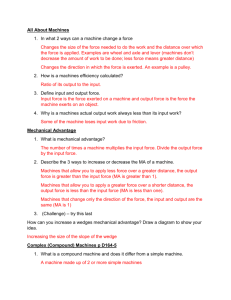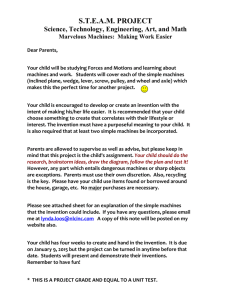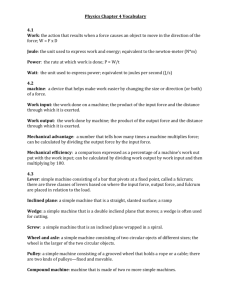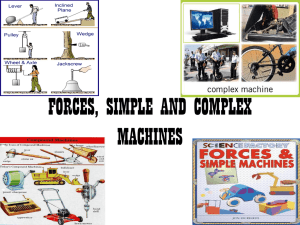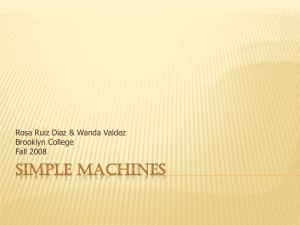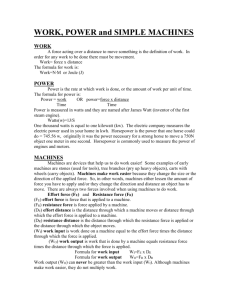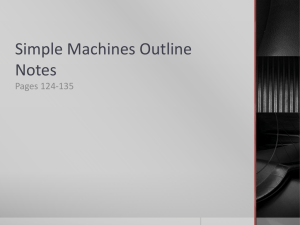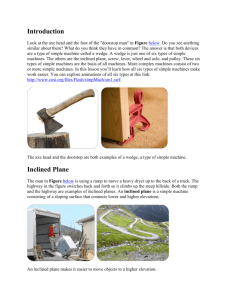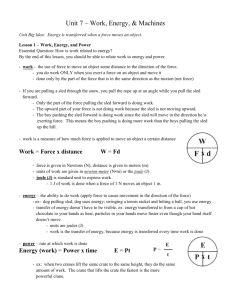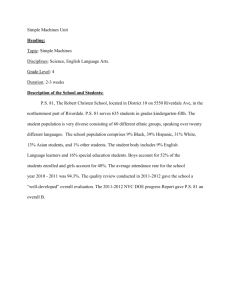A machine is a tool used to make work easier
advertisement
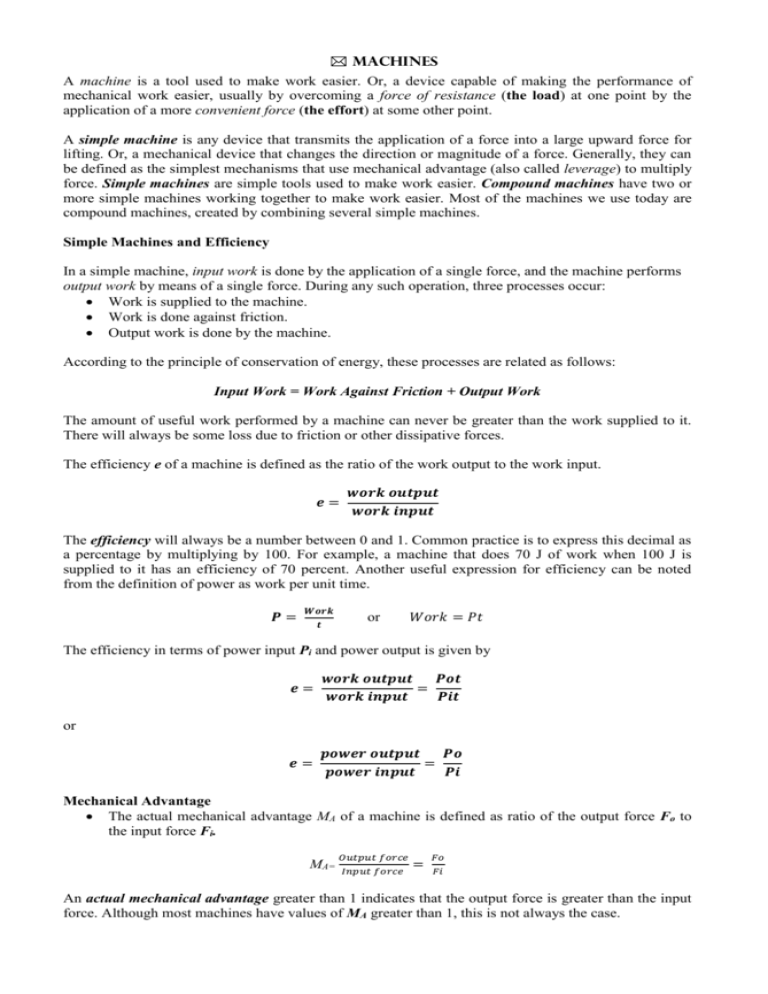
Machines A machine is a tool used to make work easier. Or, a device capable of making the performance of mechanical work easier, usually by overcoming a force of resistance (the load) at one point by the application of a more convenient force (the effort) at some other point. A simple machine is any device that transmits the application of a force into a large upward force for lifting. Or, a mechanical device that changes the direction or magnitude of a force. Generally, they can be defined as the simplest mechanisms that use mechanical advantage (also called leverage) to multiply force. Simple machines are simple tools used to make work easier. Compound machines have two or more simple machines working together to make work easier. Most of the machines we use today are compound machines, created by combining several simple machines. Simple Machines and Efficiency In a simple machine, input work is done by the application of a single force, and the machine performs output work by means of a single force. During any such operation, three processes occur: Work is supplied to the machine. Work is done against friction. Output work is done by the machine. According to the principle of conservation of energy, these processes are related as follows: Input Work = Work Against Friction + Output Work The amount of useful work performed by a machine can never be greater than the work supplied to it. There will always be some loss due to friction or other dissipative forces. The efficiency e of a machine is defined as the ratio of the work output to the work input. 𝒆= 𝒘𝒐𝒓𝒌 𝒐𝒖𝒕𝒑𝒖𝒕 𝒘𝒐𝒓𝒌 𝒊𝒏𝒑𝒖𝒕 The efficiency will always be a number between 0 and 1. Common practice is to express this decimal as a percentage by multiplying by 100. For example, a machine that does 70 J of work when 100 J is supplied to it has an efficiency of 70 percent. Another useful expression for efficiency can be noted from the definition of power as work per unit time. 𝑷= 𝑾𝒐𝒓𝒌 𝒕 or 𝑊𝑜𝑟𝑘 = 𝑃𝑡 The efficiency in terms of power input Pi and power output is given by 𝒆= 𝒘𝒐𝒓𝒌 𝒐𝒖𝒕𝒑𝒖𝒕 𝑷𝒐𝒕 = 𝒘𝒐𝒓𝒌 𝒊𝒏𝒑𝒖𝒕 𝑷𝒊𝒕 𝒆= 𝒑𝒐𝒘𝒆𝒓 𝒐𝒖𝒕𝒑𝒖𝒕 𝑷𝒐 = 𝒑𝒐𝒘𝒆𝒓 𝒊𝒏𝒑𝒖𝒕 𝑷𝒊 or Mechanical Advantage The actual mechanical advantage MA of a machine is defined as ratio of the output force Fo to the input force Fi. MA= 𝑂𝑢𝑡𝑝𝑢𝑡 𝑓𝑜𝑟𝑐𝑒 𝐼𝑛𝑝𝑢𝑡 𝑓𝑜𝑟𝑐𝑒 = 𝐹𝑜 𝐹𝑖 An actual mechanical advantage greater than 1 indicates that the output force is greater than the input force. Although most machines have values of MA greater than 1, this is not always the case. In science, work is defined as a force acting on an object to move it across a distance. Pushing, pulling, and lifting are common forms of work. Furniture movers do work when they move boxes. Gardeners do work when they pull weeds. Children do work when they go up and down on a see-saw. Machines make their work easier. The furniture movers use a ramp to slide boxes into a truck. The gardeners use a hand shovel to help break through the weeds. The children use a see-saw to go up and down. The ramp, the shovel, and the see-saw are simple machines. Inclined Plane A plane is a flat surface. For example, a smooth board is a plane. Now, if the plane is lying flat on the ground, it isn't likely to help you do work. However, when that plane is inclined, or slanted, it can help you move objects across distances. And, that's work! A common inclined plane is a ramp. Lifting a heavy box onto a loading dock is much easier if you slide the box up a ramp--a simple machine. Want to know more? Wedge Instead of using the smooth side of the inclined plane, you can also use the pointed edges to do other kinds of work. For example, you can use the edge to push things apart. Then, the inclined plane is a wedge. So, a wedge is actually a kind of inclined plane. An axe blade is a wedge. Think of the edge of the blade. It's the edge of a smooth slanted surface. That's a wedge! Want to know more? Screw Now, take an inclined plane and wrap it around a cylinder. Its sharp edge becomes another simple tool: the screw. Put a metal screw beside a ramp and it's kind of hard to see the similarities, but the screw is actually just another kind of inclined plane. How does the screw help you do work? Every turn of a metal screw helps you move a piece of metal through a wooden space. And, that's how we build things! Want to know more? Lever Try pulling a really stubborn weed out of the ground. You know, a deep, persistent weed that seems to have taken over your flowerbed. Using just your bare hands, it might be difficult or even painful. With a tool, like a hand shovel, however, you should win the battle. Any tool that pries something loose is a lever. A lever is an arm that "pivots" (or turns) against a "fulcrum" (or point). It is made of a rigid bar that rotates about a fixed point, called the fulcrum. They affect the effort, or force, needed to do a certain amount work. Think of the claw end of a hammer that you use to pry nails loose. It's a lever. It's a curved arm that rests against a point on a surface. As you rotate the curved arm, it pries the nail loose from the surface. And that's hard work! Wheel and Axle The rotation of the lever against a point pries objects loose. That rotation motion can also do other kinds of work. Another kind of lever, the wheel and axle, moves objects across distances. The wheel, the round end, turns the axle, the cylindrical post, causing movement. On a wagon, for example, the bucket rests on top of the axle. As the wheel rotates the axle, the wagon moves. Now, place your pet dog in the bucket, and you can easily move him around the yard. On a truck, for example, the cargo hold rests on top of several axles. As the wheels rotate the axles, the truck moves. Pulley A simple machine used to lift objects. It consists of a grooved wheel or disk within a housing, and a rope or cable threaded around the disk. The disk of the pulley rotates as the rope or cable moves over it. Pulleys are used for lifting by attaching one end of the rope to the object, threading the rope through the pulley (or system of pulleys), and pulling on the other end of the rope. Instead of an axle, the wheel could also rotate a rope or cord. This variation of the wheel and axle is the pulley. In a pulley, a cord wraps around a wheel. As the wheel rotates, the cord moves in either direction. Now, attach a hook to the cord, and you can use the wheel's rotation to raise and lower objects. On a flagpole, for example, a rope is attached to a pulley. On the rope, there are usually two hooks. The cord rotates around the pulley and lowers the hooks where you can attach the flag. Then, rotate the cord and the flag raises high on the pole. If two or more simple machines work together as one, they form a compound machine. Most of the machines we use today are compound machines, created by combining several simple machines. Can you think of creative ways to combine simple machines to make work easier? Think about it.



